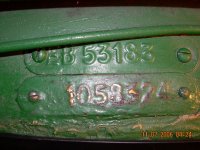angelfj1
Yoda
Offline
Re: Project Update - Body ID Tags - Success
Peter: Then I bought the 3A back in 1986, it was a near basket case. or as a good friend of mine from NC says, "she looks like she was rode hard and put up wet". So, the lower "Mulliner's tag was 50 percent eaten away and I couldn't even guess the numbers. Well maybe 10 years ago, I sent off to BMIHT and got he records. Perhaps I was lucky, but everything matched. The commission number, engine number and "EB" number. So my confidence that the correct Mulliner's number was high. If you haven't done this you might consider contacting them at: https://www.heritage-motor-centre.co.uk/
<u>The Mulliner family has its roots set deeply in BMI history, being one of the original builders of coaches for the royal mail. Just a bit of trivia, I didn't realize until I read this today. From 1958, Triumph owned Mulliners. I had always considered them a "vendor" and not actually a part of Triumph. </u>
<span style='font-size: 8pt'>This company seems to have originated around 1896 and built a few bodies for Daimler before deciding the future lay in making large production runs for motor companies that did not have their own facilities. An early contract was gained from Calthorpe, then a booming company, leading to probably the entire output going to them and eventual close financial and corporate links between the two. After Calthorpe failed in 1924, the managing director of Mulliners, Louis Antweiler, arranged to buy the coachbuilding company which was then renamed Mulliners Ltd. He obtained contracts with Clyno and Austin for who he made many Weymann style fabric bodies for the Austin 7. When the fashion for fabric bodies declined the business with Austin went but was replaced by orders from Hillman, Humber, Standard and Lanchester. In 1929 the company went public. The main business was now with Daimler and Lanchester wherre they made the bodies for the cheaper range of cars with confusingly, Arthur Mulliner of Northampton making the up-market models. Alvis was added to the list of customers. During World War 2 they made bodies for military vehicles and troop carrying gliders. After the war body making for cars resumed with Aston Martin, Armstrong Siddeley and Triumph joining the list of customers. <u>Standard-Triumph had by then a shortage of body making capacity and this led them to buy the company in 1958. The name disappeared in 1962.</span></u>
Peter: Then I bought the 3A back in 1986, it was a near basket case. or as a good friend of mine from NC says, "she looks like she was rode hard and put up wet". So, the lower "Mulliner's tag was 50 percent eaten away and I couldn't even guess the numbers. Well maybe 10 years ago, I sent off to BMIHT and got he records. Perhaps I was lucky, but everything matched. The commission number, engine number and "EB" number. So my confidence that the correct Mulliner's number was high. If you haven't done this you might consider contacting them at: https://www.heritage-motor-centre.co.uk/
<u>The Mulliner family has its roots set deeply in BMI history, being one of the original builders of coaches for the royal mail. Just a bit of trivia, I didn't realize until I read this today. From 1958, Triumph owned Mulliners. I had always considered them a "vendor" and not actually a part of Triumph. </u>
<span style='font-size: 8pt'>This company seems to have originated around 1896 and built a few bodies for Daimler before deciding the future lay in making large production runs for motor companies that did not have their own facilities. An early contract was gained from Calthorpe, then a booming company, leading to probably the entire output going to them and eventual close financial and corporate links between the two. After Calthorpe failed in 1924, the managing director of Mulliners, Louis Antweiler, arranged to buy the coachbuilding company which was then renamed Mulliners Ltd. He obtained contracts with Clyno and Austin for who he made many Weymann style fabric bodies for the Austin 7. When the fashion for fabric bodies declined the business with Austin went but was replaced by orders from Hillman, Humber, Standard and Lanchester. In 1929 the company went public. The main business was now with Daimler and Lanchester wherre they made the bodies for the cheaper range of cars with confusingly, Arthur Mulliner of Northampton making the up-market models. Alvis was added to the list of customers. During World War 2 they made bodies for military vehicles and troop carrying gliders. After the war body making for cars resumed with Aston Martin, Armstrong Siddeley and Triumph joining the list of customers. <u>Standard-Triumph had by then a shortage of body making capacity and this led them to buy the company in 1958. The name disappeared in 1962.</span></u>

 Hi Guest!
Hi Guest!

 smilie in place of the real @
smilie in place of the real @
 Pretty Please - add it to our Events forum(s) and add to the calendar! >>
Pretty Please - add it to our Events forum(s) and add to the calendar! >> 







